Brief history of Stephenson Memorial Hall
We take a look at the history of the building that is the home of the Chesterfield Museum.
The Stephenson Memorial Hall
As its name suggests, the Stephenson Memorial Hall commemorates the town’s connection to George Stephenson. Built in 1879 on the corner of Corporation Street and St Mary’s Gate, it was intended for adult education.
The project was an initiative of two local societies, the Chesterfield Institute of Engineers and the Chesterfield and Derbyshire Institute of Mining, Civil and Mechanical Engineers. The building housed classrooms for art and science, a public hall, lecture hall and a library.
However, the cost of the building, most of which was raised by donations, was too much and the trustees could not pay off the debt. As a result the property was sold to the Chesterfield Corporation in 1889 for £4,000.
The cost of the scheme to build a hall (£13,735) was reliant on public donations and fundraisers. Many prominent local people and companies gave money; the Duke of Devonshire gave £500 and the Stanton Coal and Iron Co. gave £250. This was not enough, however, and the trustees could not pay off the debt. The Corporation bought the Hall in 1889.

The building of the Stephenson Memorial enabled the Corporation to provide a free library for the town. The library opened in November 1880, a year after the rest of the building’s facilities, and books included the works of Charles Dickens, Sir Walter Scott and Charlotte Bronte.
The foundation stone for the Stephenson Memorial Hall was laid in October 1877 by the Marquis of Hartington and was officially opened in July 1879 by the Duke of Devonshire. This was celebrated by a banquet and a grand concert in the hall.
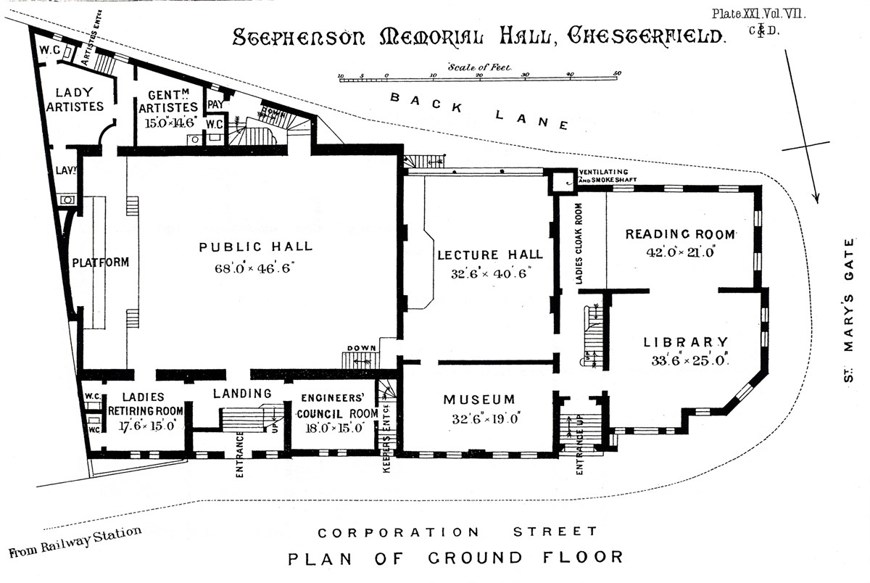
A plan showing the layout of the Hall’s ground floor when it opened in 1879. The art room, laboratory and science class room were on the first floor.
The idea for a new public hall was first put forward in 1871 by Charles Binns, friend and colleague of George Stephenson. He said, ‘There is no efficient public library in the town, no museums, model room or gallery…. there is no place where any innocent recreation for the inhabitants can be enjoyed – free’.
The Chesterfield and Brampton Mechanics Institute was an organisation dedicated to improving the education of working people. The Institute had rooms at the Market Hall but by the 1870s, they were not longer suitable for the classes and lectures it now provided. Similarly the Chesterfield and Derbyshire Institute of Mining, Civil and Mechanical Engineers had nowhere permanent and suitable to meet.
The Chesterfield and Brampton Mechanics Institute was an organisation dedicated to improving the education of working people. The Institute had rooms at the Market Hall but by the 1870s, they were not longer suitable for the classes and lectures it now provided. Similarly the Chesterfield and Derbyshire Institute of Mining, Civil and Mechanical Engineers had nowhere permanent and suitable to meet.
The public hall on the ground floor, which had a small platform or stage, was used for a wide range of meetings, performances and celebrations.
A public building
After the Stephenson Memorial Hall came into council ownership in 1889, land was acquired at the east end of the building to enlarge the public hall and adapt it as a theatre. It opened in 1898 with a new stage and dressing rooms and became known as the Corporation Theatre, hosting a variety of plays, concerts and local amateur productions. In 1926, the theatre was leased to a cinema company and films were the main entertainment until 1948.
The west side of the building also underwent changes. By 1902 the science and art classes were no longer running. As a result, in 1905 the ground floor was adapted for use as a council chamber, committee rooms and Mayor’s parlour while the library was moved to the first floor.
Before its extension in 1898, the public hall in the Stephenson Memorial Hall only had a shallow stage and small changing rooms. With the new addition, the capacity was increased to over 1100.

This programme advertises ‘Don Q -son of Zorro’, a popular silent film of the 1920s. After the lease of the theatre to a cinema company in 1926, films were mainly shown. They were initially silent with the music provided by an orchestra but in 1931 a sound system was installed launching a new era of films. The cinema lease expired in 1948 and in 1949 this part of the building became a theatre once more; the Civic Theatre.
The first meeting in the new council chamber, previously the lecture hall, took place in September 1905. Previously council meetings had been held at the municipal hall on the corner of Beetwell Street and South Street but the facilities were shared with the police and magistrates courts, which was not ideal.

The Corporation Theatre hosted a range of performances by local amateur groups such as Chesterfield Orchestral Society and Chesterfield Amateur Operatic Society.

George Eastwood became mayor in 1905 shortly the Corporation moved into the Stephenson Memorial Hall and the renovations included a mayor’s parlour. He is pictured here with the distinctive wooden panelling of the hall’s interior in the background.
A public library
Chesterfield’s first free public library opened its doors in the Stephenson Memorial Hall in November 1880. Prior to this, the only libraries in the town were based on subscriptions.
The first books were acquired through a donation of £100 by Charles Markham and a gift of books by the Mechanics Institute but the library struggled to fill the shelves until a subscription library was set up in 1884. Their books were transferred to the free library after a year in circulation.
The opening of the new town hall in 1938 enabled the library to expand and occupy the entire west end of the building and it continued to do so until 1985 when a new library was opened on Beetwell Street.

When the new town hall was built in 1938, it was initially suggested that the old council chamber and committee rooms should be used as the town’s court house. In the end however, it was decided that the library should be expanded. The reference library and lending library were transferred to the ground floor while an exhibition and lecture room were on the first floor. Alterations were completed in September 1939 but there was no official opening due to the onset of the Second World War.
Assistant librarian, George MacMahon, became the chief librarian in 1909 after the death of his predecessor, Dennis Gorman. Gorman was a forceful character, who argued with his employers on many occasions about the lighting and ventilation in the library, but he was largely responsible to building up the library collection. MacMahon was librarian until his death in 1921.

The public lending library in the 1950s (above). In 1955 the reference library was moved back to the first floor and the lending section expanded to twice the size.
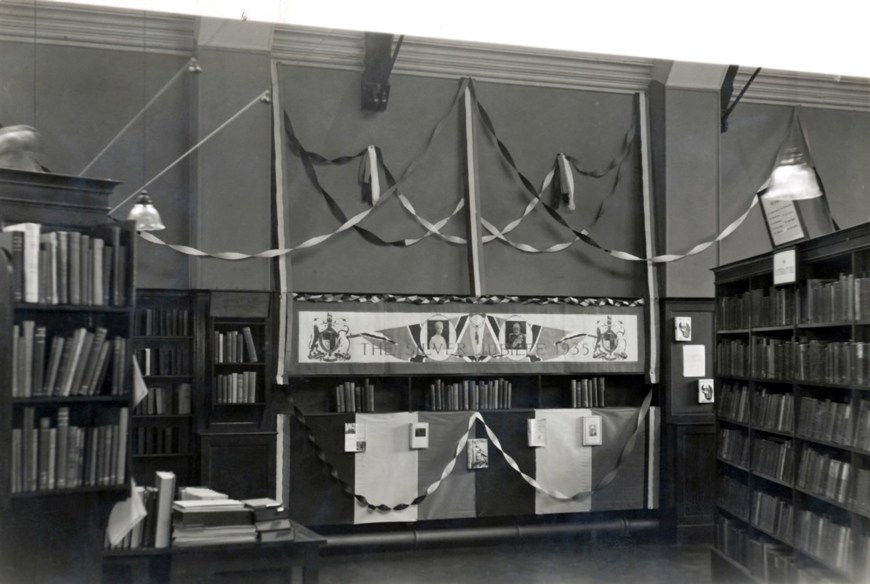
The first children’s library in Chesterfield opened in 1936 on the first floor of the Stephenson Memorial Hall. This section had previously been the reading rooms which moved to Church Way in 1935. The children’s library was moved to New Square in 1969.
The reference library (pictured above) decorated for the sliver jubilee of King George V in 1935. The books are shown here in an open access system rather than readers having to request them. This was the result of a complete re-organisation in 1927 after a damning report by Sheffield’s chief librarian. The book stock was described as ‘deplorable’ and the cataloguing and skills of the librarian (he wasn’t qualified) were also criticised.
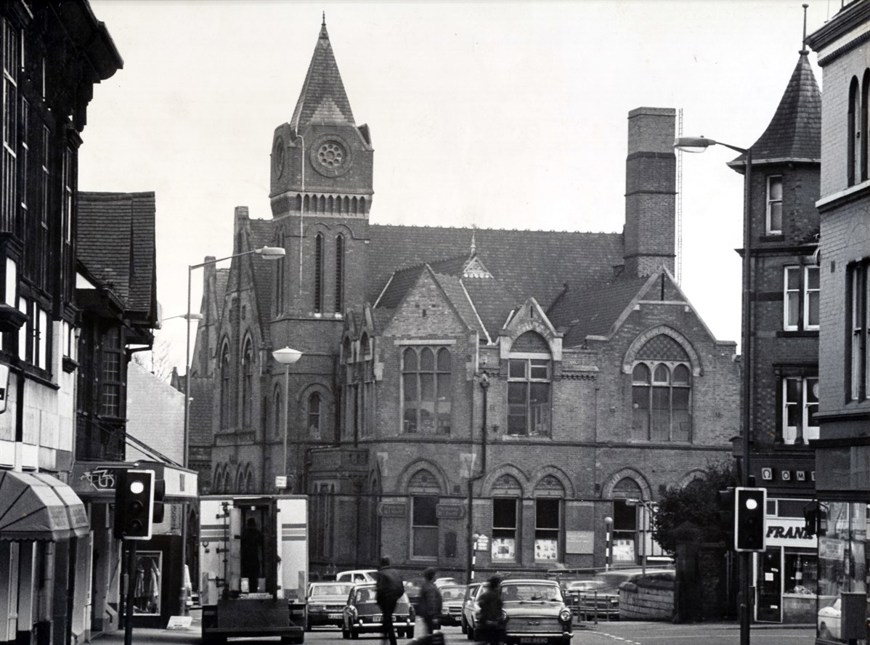
The Stephenson Memorial Hall in 1978. After the re-organisation of local government, the control of Chesterfield’s library passed to Derbyshire County Council in 1974.
A museum for Chesterfield
A museum for Chesterfield was first looked at seriously in the 1920s. The Borough Records and Museum Committee, formed in 1921, had the responsibility of looking after the town’s historic documents and objects with a view to creating a museum and in 1925, when Tapton House was given to the town, it looked like becoming a reality. Tapton House, however, was to become a school in 1930 and it was decided that ‘the establishment of a museum be postponed until a more opportune time.’
By the late 1980s, plans for a museum in Chesterfield were finally underway and in May 1994, after many years of planning and anticipation, Chesterfield finally opened its town museum at the Stephenson Memorial Hall.
The location for the museum was initially going to be at the site of the Revenues Hall (later the Customer Service Centre) in New Square. However in July 1988, the building was required by the Revenues Department to facilitate the Community Charge or Poll Tax and the museum service needed to look for a new home.

The idea of a museum for Chesterfield was looked into by the council as early as the 1920s. Charles Markham suggested that Tapton House may be a suitable venue in his 1925 letter giving the house and grounds to the town. After Tapton House’s closure as a school in 1991, it was among the suggestions again as a museum venue. In 1992, however the Stephenson Memorial Hall was chosen.
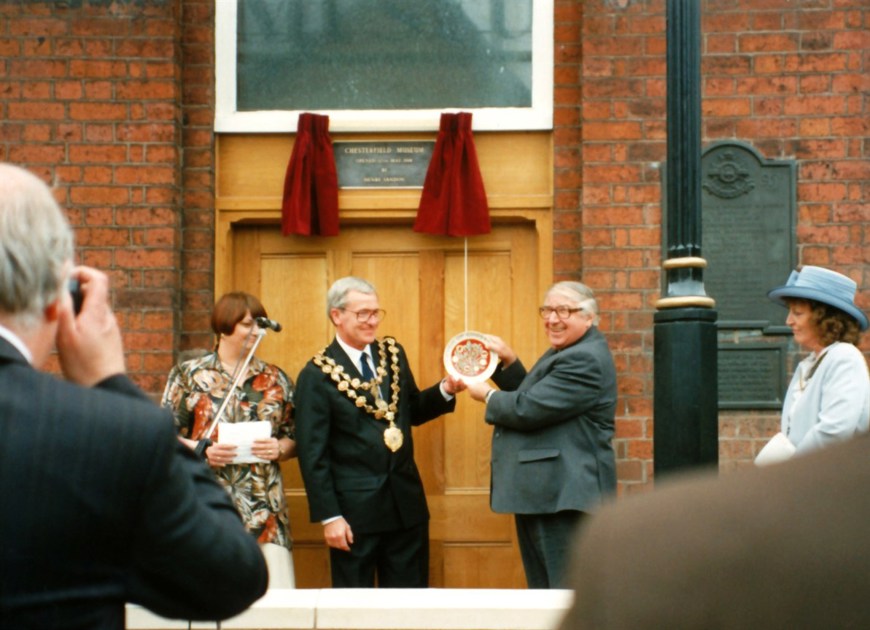
The museum was opened on 12 May 1994 by Henry Sandon of Antiques Roadshow fame. By the October, the museum had clocked up its 10,000 visitor. By March 2018, over 600,000 visitors had been through the museum’s doors.

Throughout its history the museum has provided a varied programme of special events and temporary exhibitions on local themes using the museum’s collection.
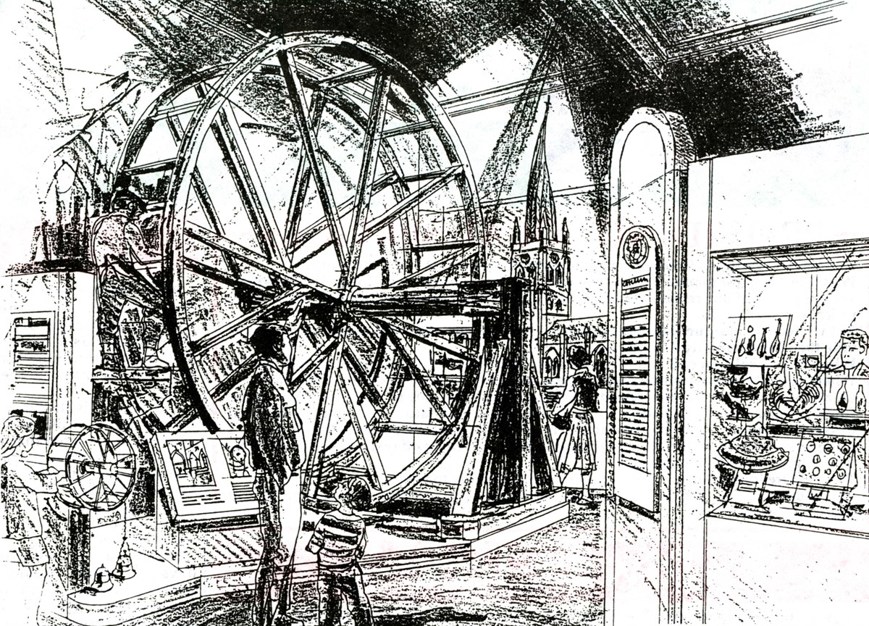
An artist’s impression of the museum’s largest exhibit, the builder’s wheel, which formed part of the initial designs for the museum.
Over the years the Council built up a collection of objects relating to Chesterfield’s history. From the late 1980s until 1994, with plans being developed for a museum, these items were displayed in a series of temporary exhibitions in the town’s Tourist Information Centre at the time - the Peacock Centre.